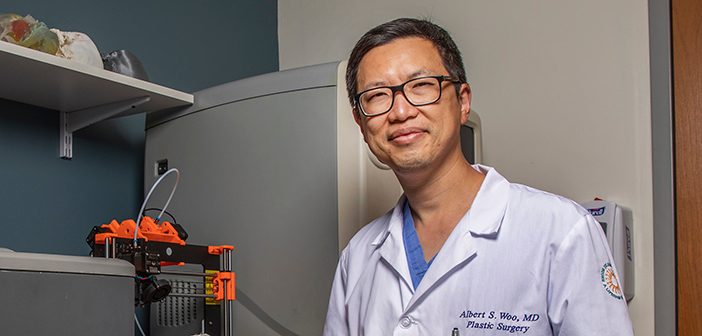Craniofacial surgeons like Albert Woo ’95 MD’99 RES’05 indulge their inner artists as they sculpt new noses, jaw bones, and eyebrow ridges for victims of gunshots and car crashes and cancer. But they don’t want to get too creative; they want a prosthetic nose, say, to fit their patient’s face. In the old days, Woo would have referenced CT scans and X-rays and then drawn on his two decades of experience to “figure it out in the operating room.” No more. As director of the Lifespan 3D Printing Lab, the associate professor of surgery, of pediatrics, and of neurosurgery can eliminate the questions by creating a life-size model of the nose in a matter of hours and plan the surgery in advance. “I don’t have to guess or make things up on the fly. I know exactly what I need to do,” he says. A new surgeon would, too: “It levels the playing field.” The potential goes beyond plastic surgery: 3D prints from his lab help physicians plan spinal, heart, and fetal surgeries, even in emergencies. Hand models allow trainees to practice sewing tendons before encountering the real thing. Casts for burn masks require a patient to just sit for a photo, no plaster needed. “Honestly, we’re just skimming the surface now,” Woo says.
STRIKE A POSE
An elaborate 3D camera array captures patient photos; an algorithm then merges them to make the models. “Someday it will get replaced by an iPhone,” says lab coordinator Joe Crozier.
PACKAGE DEAL
Woo helped develop the 3D printing lab at Washington University in St. Louis before Brown recruited him back in 2016—with the promise he could start a new lab here.
SUPER MODEL
Even seasoned surgeons have more to learn; Crozier says a 3D spine model “literally changed what the chief of neurosurgery was going to do … just by being able to see it and hold it.”
CHILD’S PLAY
Woo got a 3D printer for his son and daughter to learn engineering and design. Now every holiday, “my kids don’t make cards,” he says, “they design cool stuff on the 3D printer.” NO MORE MAIL ORDER 3D models aren’t new to medicine, but few hospitals have their own lab; most order them commercially, which can take a week or more and costs 10 times as much, Woo says.




